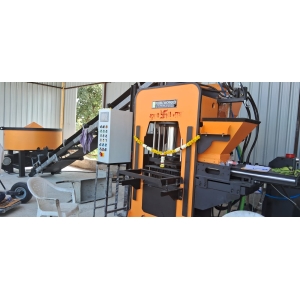Fly Ash Brick Making Machine
Efficient Fly Ash Brick Making Machine – Designed for high-performance and precision, this machine ensures durable and eco-friendly brick production. With robust construction and automated operation, it delivers consistent quality, reducing labor costs and increasing output. Ideal for sustainable construction, it supports various brick sizes and shapes
Description
Fly Ash Brick Making Machines are at the forefront of Possible Machineries’ offerings. These machines are designed to manufacture fly ash bricks, which are made from a mixture of fly ash, lime, gypsum, and other stabilizing agents. Fly ash bricks are not only eco-friendly but also cost-effective, making them an ideal choice for sustainable construction.
The machines are engineered to produce bricks with high strength, low water absorption, and excellent durability. The use of fly ash as the primary raw material reduces the dependency on natural resources like clay, contributing to environmental preservation by utilizing industrial by-products. With an efficient production process, Possible Machineries’ Fly Ash Brick Making Machines help save time, reduce labor costs, and ensure consistent quality.
Fly Ash Brick Making Machine: Efficient, Sustainable, and Cost-Effective
Overview
The Fly Ash Brick Making Machine is a groundbreaking solution for the production of durable and eco-friendly fly ash bricks. These bricks are made using fly ash, a byproduct of thermal power plants, which is typically waste material. The machine combines fly ash with other materials such as cement, sand, and water to create strong, high-quality bricks that meet the highest industry standards. The Fly Ash Brick Making Machine represents a sustainable approach to building materials, turning waste into value while reducing environmental impact.
These machines are designed for both small and large-scale production, offering automation, precision, and efficiency. With advancements in technology, manufacturers can now produce fly ash bricks with high compressive strength, uniform size, and perfect finishing, making them ideal for construction purposes.
Key Features of Fly Ash Brick Making Machine
🌱 Eco-Friendly: Utilizes fly ash, an industrial byproduct, reducing waste and promoting sustainability.
🏗️ High-Quality Output: Produces bricks with excellent compressive strength, durability, and smooth finish.
🔧 Fully Automated: Simplifies production with minimal human intervention, reducing labor costs.
💡 Energy Efficient: Lower energy consumption compared to traditional brick-making methods.
📏 Customizable Molds: Ability to produce various sizes and types of bricks, such as solid, hollow, and interlocking bricks.
⚙️ Scalable Production: Available in different capacities to meet varying production requirements.
Machinery Involved in Fly Ash Brick Making
The Fly Ash Brick Making Machine comprises several key components that work together to ensure smooth and efficient production. Here’s a breakdown of the machinery involved:
1. Raw Material Feeding System
Function: Delivers the necessary raw materials—fly ash, sand, cement, and water—into the mixing chamber.
Components:
Belt Conveyors: Transport materials to the feeding area.
Screw Feeders: Help in precise measurement and delivery of fly ash, cement, and aggregates.
Benefit: Ensures consistent material supply for accurate batching and mixing.
2. Automatic Batching and Mixing System
Function: Accurately measures and mixes the raw materials in a consistent ratio.
Features:
Weighing Hoppers: Ensure precise measurement of fly ash, sand, cement, and water.
Pan Mixer: A powerful mixer to combine the ingredients thoroughly.
Advantage: Ensures uniformity and consistency in the raw material mix, leading to uniformly high-quality bricks.
3. Hydraulic Pressing Machine
Function: The hydraulic press is used to compress the mixed material into molds under high pressure. This step is crucial for producing bricks with the required density and strength.
Key Specifications:
Hydraulic Pressure: High compression force for maximum density and strength.
Cycle Time: Typically around 10–15 seconds per brick.
Benefits:
Produces high-strength bricks with reduced voids.
Ensures that the bricks are compact and well-formed.
4. Brick Molding Machine
Function: Shapes the fly ash mix into bricks of different sizes and shapes, including solid, hollow, or interlocking.
Key Features:
Interchangeable Molds: Allows for flexibility in producing different types of bricks.
Automatic Ejection: The bricks are automatically ejected from the molds once they are compacted.
Benefit: Provides flexibility in production, allowing for various brick sizes and types.
5. Curing System
Function: Curing is an essential step to strengthen the fly ash bricks. This process allows the bricks to dry and harden, ensuring they meet the required compressive strength.
Methods:
Air Curing: Blocks are left to air dry in a controlled environment for a specified period.
Steam Curing: Accelerates the curing process using steam chambers, reducing the overall curing time.
Benefit: Ensures bricks meet strength and durability standards, providing long-lasting performance.
6. Pallet Feeding and Handling System
Function: Pallets are automatically fed to the molding machine and then transferred to the curing area for drying.
Components:
Conveyor Systems: For easy transportation of pallets and finished bricks to the curing chamber or storage area.
Stacking System: Can be automated or semi-automated to stack the blocks after production.
Benefit: Reduces manual labor, increases production efficiency, and ensures smooth operation.
7. Vibration System
Function: Vibrates the mix in the molds to remove air pockets, ensuring even compaction and high-quality brick production.
Specification:
Vibrating Motors: Operate at a controlled frequency to ensure thorough compaction and consistency in every brick.
Benefit: Improves the density and strength of the bricks while also providing a smooth surface finish.
8. Control Panel
Function: The control panel allows operators to monitor and manage the entire production process, from raw material feeding to brick molding.
Features:
Programmable Logic Controller (PLC): For automated control and real-time monitoring of machine operations.
Touchscreen Interface: User-friendly interface for easy operation and adjustment.
Benefit: Simplifies operation and helps in ensuring a high level of precision and quality control.
Optional Add-Ons for Enhanced Functionality
Water Recycling System: Recycles water used in production, reducing water wastage and operational costs.
Mold Lubrication System: Automatically lubricates molds to ensure smooth operation and easy release of bricks.
Automatic Packing System: For automated packaging of finished bricks, making them ready for delivery and reducing labor costs.
Production Workflow with Fly Ash Brick Making Machine
Material Batching: Raw materials like fly ash, cement, sand, and water are measured and fed into the mixing system.
Mixing: The ingredients are mixed uniformly in the mixer.
Molding and Pressing: The mixture is poured into molds, which are then compressed under hydraulic pressure to form the bricks.
Curing: The bricks are cured (either air-dried or steam-cured) to achieve the desired strength.
Stacking and Dispatch: The cured bricks are stacked and stored for dispatch to construction sites.
Benefits of Fly Ash Bricks
Environmental Sustainability: Fly ash bricks help reduce the environmental impact by recycling industrial waste and reducing the need for conventional fired bricks, which consume large amounts of energy.
Strength and Durability: Fly ash bricks have excellent compressive strength, making them suitable for a variety of construction applications.
Thermal Insulation: They offer superior thermal insulation, helping to maintain indoor temperatures and reduce energy costs.
Cost-Effective: Fly ash bricks are typically more affordable than traditional clay bricks, especially due to the reduced cost of raw materials.
Eco-Friendly Construction: By using a waste material like fly ash, these bricks contribute to more sustainable and eco-friendly building practices.





Reviews
There are no reviews yet.